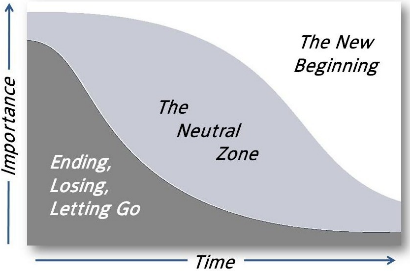Engagement as a Leader
People are shaped by their previous experiences with change. This, and their own individual characteristics, may influence how they respond to change. While change can be enthusiastically welcomed, resistance to change is very likely something every leader will face at some point.
Why is engagement important?
Engaging people in change through conversation, transparency and involvement in change activity creates a more welcome environment for change which leads to quicker embedding of change, sustained change and early realisation of benefits.
For leaders understanding how people are feeling about change, and taking appropriate action, can be the difference between success and failure. For those impacted by change understanding why they are feeling the way they do can help them accept change and adapt.

Bridges' theroy in engaging people about change
William Bridges was an organisational consultant. He put forward the idea that understanding the transition people went through as they moved through change was key to successful change.
Bridges three primary phases of transition
The first phase
The first phase is ‘ending’ which happens before transition can take place and is the most vulnerable time for people to accept change, although a small proportion may already be focused on the new vision. Engagement strategies need to account for a sense of loss and letting go.
The second phase
The second phase is ‘the neutral zone,’ where, if engaged properly, acceptance to change will have increased and people are generally understanding the need for change and its future benefits. Ideas and innovation are most likely to occur at this time as people are open and willing to listen, and will actively want to contribute to the new vision.
The final phase
The final phase is ‘new beginnings’ where the majority of people have bought into the vision and want the same desired outcome. However, not everyone will be on board despite best efforts and this can be for many reasons which will need to be tackled. Monitoring how people are feeling in the new world will also help to ensure its long term success.
